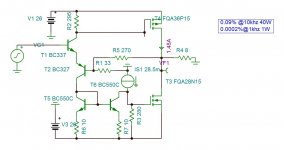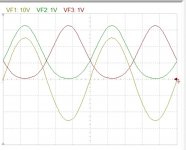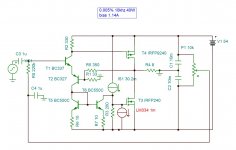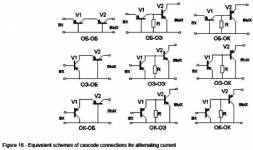I am experimenting to transform the single front-end into push pull. I came upon this type of circuit. Note that the power mosfets can be VAS stage. The lower current of the Rush is inverted by current mirror subtracting a fixed CCS which adjusts the bias current 1.48A. As the same current of the rush subtracts itself , the distortion goes very low 0.0002% @1khz 1W , in worst case 0.09% @10khz 40W. The power mosfets work in square law bias they are thermally stabilized by LM334 mounted upon . This circuit is designed in less than an hour, To morrow , I 'll post with Single Floating Supply to take care of the offset.
Hayk
Attachments
Member
Joined 2009
Paid Member
very interesting !
fyi - Hugh Dean proposed something like this a few years ago, he's used the Christopher Rush Cascode in at least one of his amplifiers.
I don't know if you need the current mirror, lowest possible simulated distortion maybe not the only goal.
fyi - Hugh Dean proposed something like this a few years ago, he's used the Christopher Rush Cascode in at least one of his amplifiers.
I don't know if you need the current mirror, lowest possible simulated distortion maybe not the only goal.
very interesting !
fyi - Hugh Dean proposed something like this a few years ago, he's used the Christopher Rush Cascode in at least one of his amplifiers.
I don't know if you need the current mirror, lowest possible simulated distortion maybe not the only goal.
I couldn't find any Rush cascode by AKSA, through search engines.
What the other goals might be?
Member
Joined 2009
Paid Member
There are Rush Cascode designs all over the place, but I’ll let Hugh publish his own work because his first posting of this idea was buried in another thread I can’t find either!
Here’s some links from the first attempt at a forum search,
Rush Cascode inputstage on JLH 10W
About rush cascode input amp vs ltp input amp
The Rush Cascode: Possible Wiki page
Rush Cascode Headphone Amp + JLH Output Stage
Rush Cascode Regulator
and another reference of interest, but you have to scroll down,
https://www.tubecad.com/2018/04/blog0421.htm
Here’s some links from the first attempt at a forum search,
Rush Cascode inputstage on JLH 10W
About rush cascode input amp vs ltp input amp
The Rush Cascode: Possible Wiki page
Rush Cascode Headphone Amp + JLH Output Stage
Rush Cascode Regulator
and another reference of interest, but you have to scroll down,
https://www.tubecad.com/2018/04/blog0421.htm
4QD-TEC: Electronics Circuits Reference Archive
Low distortion audio amplifier
4QD-TEC: Low distortion Audio amplifier
Low distortion audio amplifier
4QD-TEC: Low distortion Audio amplifier
Hi kokoriantz,Better adjusted , it can deliver 40W 10khz with 0.005% Dtot. Thanks to square law , with 1.14A bias it is still in class A at 40W.
Be aware the TINA IRFP240 does not have subthreshold conduction. See plots:
You get lower distortion from simulations without subthreshold conduction compared to real MOSFETs.
Attachments
The Rush configuration has never been formally named.
So anyone one can call it whatever they like.
It doesn't appear in any text book that I know of and none of the power amplifier design books. Maybe it should be called a "Cinderella pair" Cinderella | Definition of Cinderella at Dictionary.com
But it would be nice if we all could use one that is unambiguous. See here Methods to reduce crossover distortion?
Cheers,
So anyone one can call it whatever they like.
It doesn't appear in any text book that I know of and none of the power amplifier design books. Maybe it should be called a "Cinderella pair" Cinderella | Definition of Cinderella at Dictionary.com
But it would be nice if we all could use one that is unambiguous. See here Methods to reduce crossover distortion?
Cheers,
Cascode inclusion of transistors-circuits in which individual transistor cascades are connected in a chain without additional feedbacks. Such compounds are called regular.
Circuits in which individual transistors are connected in an arbitrary combination and with additional feedbacks. Such compounds are called irregular.
6 Каскодное включение транзисторов
These include the Rush circuit, the Sugden output stage circuit.
Some cascode schemes compensate for temperature drift and are used in DC amplifiers.
Circuits in which individual transistors are connected in an arbitrary combination and with additional feedbacks. Such compounds are called irregular.
6 Каскодное включение транзисторов
These include the Rush circuit, the Sugden output stage circuit.
Some cascode schemes compensate for temperature drift and are used in DC amplifiers.
A differential cascade on a pair of complementary transistors, and in general a transistor structure with automatic bias setting.
Hi OldDIY,Cascode inclusion of transistors-circuits in which individual transistor cascades are connected in a chain without additional feedbacks. Such compounds are called regular.
Circuits in which individual transistors are connected in an arbitrary combination and with additional feedbacks. Such compounds are called irregular.
6 Каскодное включение транзисторов
These include the Rush circuit, the Sugden output stage circuit.
Some cascode schemes compensate for temperature drift and are used in DC amplifiers.
In that reference for classification of compound pairs:
The regular cascode is mid-left (without the DC bias).
The LTP differential pair bottom left (without the CCS for DC bias).
But where is the Rush pair (with two emitters connected and PNP+NPN)?
The regular cascode is sometimes called a telescopic stage (meaning one on top of the other) in the literature.
The Rush pair doesn't fit into this category because the two emitters are holding hands they effectively act together a single device, they forms a discrete 4 terminal NPNPNP transistor with two bases and two collectors.
No emitters, so the base currents flows in one base and out the other base (well assuming matching).
It is similar to the LTP diff amp, except the Rush pair has two Vbe DC bias drop between the bases.
The LTP has an Io*Tanh([Vin1-Vin2]/[2*Vt]) transfer function.
The Rush pair has a Io*exp([Vin1-Vin2-2Vbe]/[2*Vt]) transfer function like a regular BJT.
----
BTW Cascade means one following the other, as in preamp driving a power amp.
Attachments
Last edited:
I would rather call these diabolic pair Bonnie&Clyde. The transfer function of these pair is analog XOR. Only what both have decided in common is amplified . In my precedent Rush derived from DHL but in class B , initially I had BD139/140 . I mounted them on sockets to try out different transistors. At the input PNP , I kept BC327 because it has very low Re, by this the feedbacking NPN using weeker ones express their character. Every transistor I tried gave different sound varying mainly in dynamic . It happened I had erroneously a MOSFET 2sk2182 in the bjt box , so I tried it, amazing, The high frequencies got enhanced , as if the treble is set to 3 o'clock but weaker bass. I replaced it by IRFZ44, tha bass got better but lost some highs . With IRFBC20, I got still better highs but lack of bass. As it was asking high gm with low drain -gate capacitance ,I have 3sk339 in smd but for low voltage I mounted it along a cascode. This time it sounded as if the treble control is more than maximum. I measured the frequency response with generator , flat to 100khz ??? I inserted pink noise , the spectrum of the output overlaid exactly with that of input. I plugged a software synthesizer playing piano notes, there I saw the spectrum of the output/input increase from 3khz to reach +15db at 10khz. I replaced the 3k339 with other ones , only the bass decreases . I put back the IRFBC20 without cascode and replaced the input BC327 with 3j327, all the charm disappeared , Now I mount the BC327 with 3k337 in compound Darlington , and I get as if an equalizer is set +6db 8khz and +12db 16khz with excellent bass, always the frequency response flat . For my aging ears it fits the best .
I just discover this thread. The Rush circuit is well described, like a long tail pair (LTP), as an emitters-coupled circuit. It is certainly not a cascode circuit. The first time I saw it was on the schematics of Cherry's NDFL power amplifier in magazine Electronics Today International (ETI)
Last edited:
Jan Didden has a direct link to the ETI article :
https://linearaudio.nl/sites/linearaudio.net/files/cherry%20ndfl%20amp.pdf
https://linearaudio.nl/sites/linearaudio.net/files/cherry%20ndfl%20amp.pdf
Interesting use of Rush as an LPT current amplifier. Q7 works as a follower (common collector) and Q8 is a (common base ) level shift stage.
Discrete LPT can be replaced by OPA. We get an amplifier with deep GNFB similar to Wiederhold.
https://www.diyaudio.com/community/threads/unusual-amp-from-1987.357369/page-75#post-6742896
Discrete LPT can be replaced by OPA. We get an amplifier with deep GNFB similar to Wiederhold.
https://www.diyaudio.com/community/threads/unusual-amp-from-1987.357369/page-75#post-6742896
Last edited:
- Home
- Amplifiers
- Solid State
- Rushed F5






